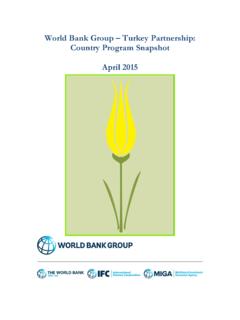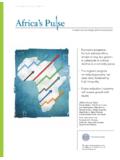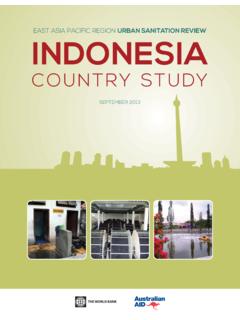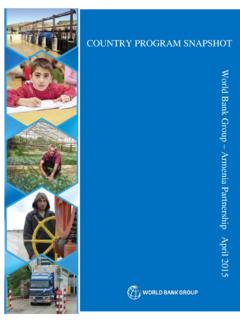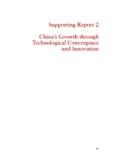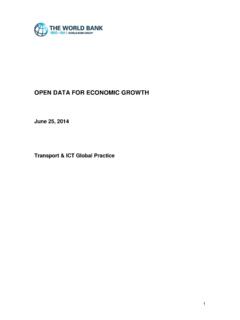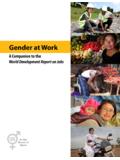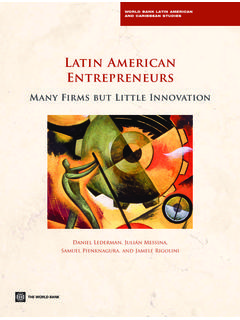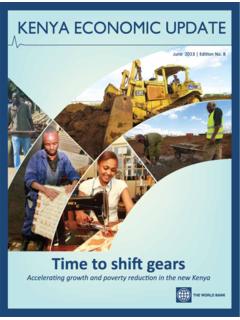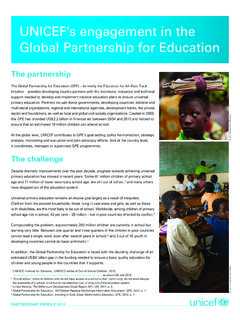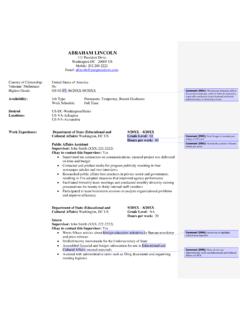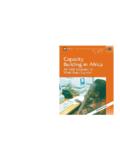Transcription of Myanmar: Empowering People for Inclusive Growth
1 myanmar : Empowering People for Inclusive Growth . Country partnership Framework for the period 2015-20171 myanmar : Empowering People for Inclusive GrowthMYANMAR COUNTRY partnership FRAMEWORK FOR THE PERIOD 2015-2017 myanmar : Empowering People for Inclusive Growth . Country partnership Framework for the period 2015-2017iReport No. 95183-MMMyanmar: Empowering People for Inclusive GrowthMYANMARCOUNTRY partnership FRAMEWORK FOR THE PERIOD 2015-201723 April 2015 myanmar : Empowering People for Inclusive Growth . Country partnership Framework for the period 2015-2017iiThe date of the last Interim Strategy Note was 1 November EQUIVALENTS 1 USD = 1,024 myanmar Kyat (MMK) (as of 26 January 2015)FISCAL YEAR 1 April to 31 March IFCK arin FinkelstonVice PresidentVivek PathakDirectorCatherine Martin and Vikram KumarTask Team Leader MIGAK eiko HondaVice PresidentRavi VishDirectorPaul BarbourTask Team Leader IDAAxel van TrotsenburgVice PresidentUlrich ZachauDirectorNikolas Myint Task Team Leader myanmar : Empowering People for Inclusive Growth .
2 Country partnership Framework for the period 2015-2017iiiACKNOWLEDGEMENTSThis Country partnership Framework (CPF) is the result of a team effort that relied on knowledge, expe-rience, and guidance from Government, civil society, private sector and development partners across myanmar and individuals across the World Bank Group. The World Bank Group would like to thank our counterparts in the Ministry of Finance and the Ministry of National Planning and Economic Develop-ment, and across the Government of myanmar , for their country leadership, inputs and advice through-out the CPF engagement. We would also like to thank all development partners and all stakeholders participating in consultations for their valuable comments and CPF was led by Nikolas Myint (IDA), Catherine Martin and Vikram Kumar (IFC) and Paul Barbour (MIGA), under the guidance of Abdoulaye Seck and Ulrich Zachau. The CPF core team included Corey Pattison, Keta Ruiz, Ana Maria Torres and Asbjorn Wee.
3 Inputs to the CPF came from extensive consultations across myanmar and in locations in Thailand and the US organized by Paul Donowitz, Meriem Gray, Sai Yarzar Htun, Shona Kirkwood and Kyaw Soe Lynn. The team is grateful to participants at these consultations for the time they took to share their views and insights. In addition, the CPF builds on the strong analytical foundations laid by the myanmar Sys-tematic Country Diagnostics, led by Khwima Nthara. Finally, the preparation of the CPF benefitted from a productive launch workshop in November 2013 organized by Edith Bowles and facilitated by Laura Bailey, and from the early leadership of its development by Kanthan Shankar. The team s work would not have been possible without the administrative support of Thida Aung, Aye Me Me Htun and Maung Maung team also wishes to thank the following People for their contributions: Reena Badiani-Magnusson, Robert Boothe, Greg Browder, Helle Buchhave, Rome Chavapricha, Constantine Chikosi, Christophe Crepin, Ruxandra Maria Floroiu, Julia Fraser, Anthony Gaeta, Xuemei Guo, Min Ye Paing Hein, Reidar Kvam, Morten Larsen, Charles Lor, Mark Miller, Shabih Mohib, Elizabeth Moorsmith, Sheila Musiime, Tenzin Dolma Norbhu, Dejan Ostojic, Hnin Hnin Pyne, Habib Rab, Sjamsu Rahardja, Rawong Rojvanit, Claudia Sadoff, Charles Schneider, Lou Scura, Lars Sondergaard, Robert Taliercio, Pamornrat Tansan-guanwong, Mathew Verghis, Xiaoping Wang, Wendy Werner, Ingo Wiederhofer, Andrea Woodhouse, May Thet Zin, and Sergiy Zorya.
4 myanmar : Empowering People for Inclusive Growth . Country partnership Framework for the period 2015-2017ivLIST OF ACRONYMSADBASEANCBMCESRCPFCSODSADTISEITI ESIAFDIFESRGSPICAICTIDPIHLCAINGOJICAKIOK NUMADBMDRIMEBMFIMPLCSMPTMSMENGONSDSPEFAP ERPFMPPPQSEMSCDSEESEZSMESMPSOESWGA sian Development BankAssociation of Southeast Asian NationsCentral Bank of MyanmarComprehensive Education Sector ReviewCountry partnership Framework Civil Society OrganizationDebt Sustainability AnalysisDiagnostic Trade Integration StudyExtractive Industries Transparency InitiativeEnvironmental and Social Impact AssessmentForeign Direct InvestmentFramework for Economic and Social ReformGeneralized System of PreferencesInvestment Climate AssessmentInformation and Communications TechnologyInternally Displaced PeopleIntegrated Household Living Conditions AssessmentInternational Non-Governmental OrganizationsJapan International Cooperation AgencyKachin Independence Organization Karen National UnionMyanmar Agricultural Development
5 BankMyanmar Development Resource InstituteMyanmar Economic BankMicro Finance InstitutionMyanmar Poverty and Living Conditions SurveyMyanmar Posts and TelecommunicationsMicro Small Medium EnterpriseNon-Governmental OrganizationNational Strategy for the Development of StatisticsPublic Expenditure and Financial AccountabilityPublic Expenditure ReviewPublic Financial ManagementPublic-Private PartnershipQualitative Social and Economic MonitoringSystematic Country DiagnosticState Economic EnterpriseSpecial Economic ZoneSmall and Medium EnterpriseStaff Monitored ProgramState Owned EnterpriseSector Working GroupMyanmar: Empowering People for Inclusive Growth . Country partnership Framework for the period 2015-2017vTABLE OF CONTENTSE xecutive Summary ..I. Introduction ..II. Country Context and Development Agenda .. Social and Political Context .. Economic Context .. Governance Profile .. Poverty Profile .. Systematic Country Diagnostic: Drivers of Poverty and Development Potential Sources of Growth and Economic Transformation.
6 Pathways for Ending Poverty and Boosting Shared Prosperity ..III. World Bank Group partnership Strategy .. Government Program and Medium Term Strategy .. Inputs to the Country partnership Framework .. Lessons from ISN Implementation .. Stakeholder Consultations .. Overview of the World Bank Group Strategy .. Consistency with the Systematic Country Diagnostic .. Flexibility and Scope for Adjustments .. The World Bank Group Program: Objectives and Planned Knowledge and Financing Support .. Implementing the Country partnership Framework .. Financial Envelopes and Instruments .. Country Financial Management and Procurement Capacities .. Addressing Implementation Challenges .. Coordination and Partnerships .. Monitoring and Data Constraints ..I V. Assessing, Managing, and Mitigating Risks to the CPF Program ..vii15571113151618212123232425303233464 64748505355 myanmar : Empowering People for Inclusive Growth .
7 Country partnership Framework for the period 2015-2017vi59606263646570717374313451561 2283541455314262932 Annexes Annex 1: Selected Indicators of Bank Portfolio Performance and 2: World Bank Portfolio (IBRD/IDA and Grants)..Annex 3: IFC Portfolio ..Annex 4: myanmar Selected Economic and Financial Indicators, 5: Indicative Activities FY15-17 of the World Bank Group in 6: Results Framework ..Annex 7: ISN Retrospective ..Annex 8: World Bank Group CPF Consultations in 9: Country Financing Parameters ..Annex 10: Map of myanmar ..Tables Table 1: Comparison of SCD and CPF Priorities ..Table 2: CPF Focus Areas and Expected Results ..Table 3: Development Partner Activities in myanmar by Sector Working Group ..Table 4: Standardized Operations Risk-Rating Tool for myanmar ..Boxes Box 1: Mainstreaming Governance in the WBG Program ..Box 2 : Conflict Sensitivity in WBG Supported Operations ..Box 3: Joint WBG Program on Access to Electricity.
8 Box 4: Impact of WBG Knowledge Work-The Example of Poverty ..Box 5: WBG Support to the Private Sector ..Box 6: The myanmar Umbrella Multi-Donor Trust Fund ..Figures Figure 1: Spatial Distribution of Poverty in myanmar ..Figure 2: Selectivity as Applied to SCD Priorities ..Figure 3: World Bank Group Support for Government Reform Strategies ..Figure 4: myanmar CPF Timeline ..ANNEXM yanmar: Empowering People for Inclusive Growth . Country partnership Framework for the period 2015-2017viiEXECUTIVE SUMMARYC ontext: Supporting a Historic Transition1. The proposed Country partnership Framework (CPF) will succeed the myanmar Interim Strategy Note (FY13-14) and be the first full country strategy for myanmar since 1984. This CPF comes at a time of great opportunity for myanmar ; over the three year period covered in this CPF, the reforms initiated in 2011 have the potential to bring myanmar into a new era of peace and prosperity. 2. myanmar s history, ethnic diversity, and geography combine into a unique set of development chal-lenges and opportunities, including (i) emergence from a long period of international isolation; (ii) widespread poverty, despite rich land, water, and mineral resource endowments; (iii) a strategic location in the fastest-growing region in the world; (iv) the role of the military and associated groups in the econ-omy; and (v) long standing armed conflict and ethnic and religious tensions.
9 myanmar is on a path of fundamental transformation, seeking to address all these challenges and opportunities Despite its potential, myanmar today is one of the least developed countries in Southeast Asia, with a legacy of conflict, isolation, and ineffective policies. With a population of million, the country has a per capita GDP of US$1,105. The poverty rate in 2010 was estimated at between and percent, with the lower rate reflecting the Government s methodology which showed a 20 percent decline since 2005 and the higher rate reflecting a more broad based methodology used by the World Poverty in myanmar is largely a rural phenomenon, with at least 70 percent of the country s poor living in rural areas. Through this CPF the World Bank Group (WBG) will scale up its engagement with myanmar to support two critical transformations underway: towards openness and integration, and empowerment and inclusion.
10 Together, these two socioeconomic shifts offer a historic opportunity and hold the key to reducing extreme poverty and boosting shared prosperity in myanmar . 4. Beginning in 2011, myanmar launched major political and economic reforms aimed at increasing openness, empowerment, and inclusion. The past years have seen a dramatic increase of political and civil liberties and a significant reduction in armed conflict, although conflict continues in Kachin and northern Shan States. At the same time, new tensions and challenges have emerged, including out-breaks of unrest affecting the country s Muslim minorities and particularly those who identify them-selves as Rohingya in Rakhine State. Parliamentary elections are scheduled for late 2015, and the com-ing years offer opportunities to deepen reforms myanmar has also begun removing constraints on commerce, trade, and private enterprise that long held back the economy.
